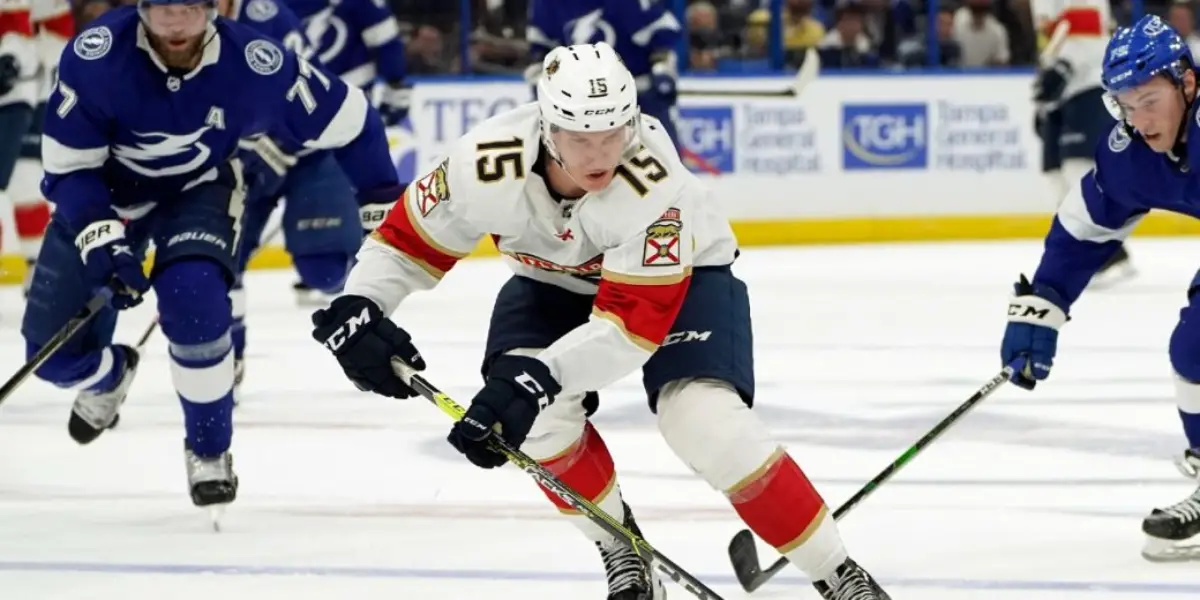
Last week, I started my preview of the Panthers roster to see how all the returning and new players fit together. The top six forwards remain the same heading into next season, with Sam Reinhart getting his long-term extension. Although it seems like Florida lost a lot of pieces things remain largely the same throughout the top three offensive lines, the only significant player they lost was Tarasenko who they had acquired at the trade deadline. The most change will be on the fourth line with the loss of Lomberg, Stenlund, and Cousins. Lomberg signed with Calgary, Stenlund went to Utah, and Cousins is currently still a free agent. A Stanley Cup win and great culture building have made Florida an attractive place for players to land, and Zito brought in some new blood to fill the holes in the roster.
Related Post: Florida Panthers Roster Preview: Forwards pt. 1
Anton Lundell:
Anton Lundell may be one of the most underrated bottom-six centers right now, but a great playoff run has made him into a somewhat bigger name. I said during my playoff coverage that Lundell would be a player who could surprise people with how he performs and he proved me right. Lundell gets time on the second power-play unit and can play up on the second line if Sam Bennett is unavailable. Anton’s great season earned him a 6-year contract extension at 5 million AAV, locking the young player up long-term with other great players like Gustav Forsling, Sam Reinhart, and Aleksander Barkov. Centering the third line, Lundell is most often playing with Eetu Luostarinen and split time with Rodrigues and Tarasenko last season; this year, that spot could get filled by Mackie Samoskevich or one of the new players. Anton played 78 games during the regular season and accumulated 13 goals & 22 assists for 35 total points and was +/- +19. He also had one power-play goal, one short-handed goal, and one game-winning goal, averaging 15:22 minutes of ice time. Lundell was second best in the faceoff circle with a faceoff win percentage of 54.9; he was second to Barkov. He won 482 faceoffs and lost 396 during the regular season. Lundell was 10th on the team in the number of shifts and fifth among the forwards at 1630, just ahead of Carter Verhaeghe. Anton played all 24 playoff games and had three goals & 14 assists for 17 points and was +/- +8. While he didn’t have any power-play goals, he did have three power-play assists and averaged 16:12 minutes of ice time. His great presence during faceoffs continued into the postseason, where he had a FO% of 52.5, just behind Barkov’s 55.2, and he won 160 and lost 145. Once again, for shifts, he was 10th most overall and 5th most among forwards in shift numbers at 572. Lundell’s a crafty player with an affinity to make shots from below the goal line that result in goals, I personally saw it no less than three times during this last season. He sees the ice well and has great puck handling just like Barkov as well as an impressive ability to make difficult passes to open players, a great example of that was his pass to Verhaeghe during OT of Game 2 against Tampa Bay.
Eetu Luostarinen:
Florida certainly likes to pair its centers with a winger, but the top three lines all have one center and winger, which are inseparable. The top line has Barkov and Reinhart, the second line is Bennett and Tkachuk, and the third line has the two Finns Lundell and Luostarinen. Eetu played all 82 regular season games and had 12 goals and 15 assists for 27 points while being +/- +1. He had two power-play goals and two game-winning goals with an average ice time of 15:56. Luostarinen takes the second most faceoffs of the non-centers, and during the regular season, he had a FO% of 53.6, winning 96 and losing 83. His strong defensive game earned him a spot on the second penalty-killing unit, and he’s been a big part of its success. With the special teams time he sees, he’s 5th most among all players and 2nd most among forwards for total shifts at 1804; he outpaced Barkov slightly due to playing more games. He also played all 24 playoff games and had two goals with six assists for eight total points and was +/- +2. He had an average ice time of 15:18. Luostarinen took fewer faceoffs during the playoffs but did have a FO% of 50, winning 19 and losing 19. Eetu was 8th most among all players and 4th most among forwards for number of shifts at 578, putting him just under Matthew Tkachuk. Luostarinen is a strong defensive forward and a great skater. His biggest room for improvement would be in goal scoring, but at only 22, he’s got a long career ahead. Luostarinen and Lundell together are a formidable bottom six pairing, and their line can skate around just about anyone to kill time off the clock.
Steven Lorentz:
The fourth line saw a bit of a revolving door of who was on it, but of the non-regulars to play on that line, Lorentz saw the most time playing 38 regular season games. He tallied one goal and two assists for three points and was +/- -9. While he didn’t see any special teams play, his one goal did account for a game-winning goal, and he averaged 8:47 minutes of ice time. Lorentz fared alright in the faceoff dot with a FO% of 48.9, winning 68 and losing 71. As for shifts he, he posted the 2nd most of the non-regulars at 500. Lorentz wasn’t originally in the starting lineup for the playoffs, but with Bennett getting hurt and Lomberg out with illness in the first round, he was called in to center the fourth line and then also play wing as needed. He played 16 games and had two goals and one assist for 3 points, with one of his goals being a game-winner. Lorentz was +/- -1 and averaged 7:07 minutes of ice time. In the faceoff circle, he was at a FO% of 41.9 and won 26 and lost 36. Lorentz played the third least amount of games and his sift total reflects that at 196. While he didn’t play a lot, there were games where the fourth line was the only set of guys who were putting in good shifts in the offensive zone and getting momentum back for the team. Lorentz is a good depth piece with room for improvement.
Jonah Gadjovich:
Gadjovich rotated in and out of the lineup as needed for the Panthers and played 39 games during the regular season. In those games, he scored two goals, had two assists for four points, and was +/- 0 with an average ice time of 7:25. He doesn’t take faceoffs for Florida and took the 4th most shifts among non-regulars at 436. Gadjovich didn’t play during the playoffs, but he & his wife did welcome twins into their family, and his team recognized that during the playoffs with Mikkola gifting him a game puck for the victory board. He’s a big and physical player who gets in heavy with the forecheck and backcheck when he’s on the ice.
Tomas Nosek:
First up for new faces is Tomas Nosek, who is coming in from New Jersey. Last season he played 36 games for the Devils with two goals, four assists for six total points, and was +/- -11. Nosek averaged 11:49 minutes of ice time and didn’t have any special teams goals. A big strength in his game is the faceoff circle, which will help offset Stenlund’s loss. Tomas’ FO% was 51.9, winning 121 and losing 112 faceoffs, and that’s the range that the Panthers like to be in with their heavy load of faceoff players. Nosak had 638 shifts in 36 games, putting him above Lorentz with more shifts in two fewer games played. He also killed penalties for New Jersey, which Florida is also looking for with Stenlund moving on to Utah. According to Zito, Nosek has a strong two-way game, which is what the Cats utilize most in their system, with quick transitions from offense to defense.
A.J. Greer:
Greer is coming to Florida after spending last season with the Calgary Flames, where he played 59 games. In that span, he scored six goals with six assists for 12 points but was +/- -7. He did score one power-play goal but had no short-handed or game-winning goals while averaging 8:49 minutes of ice time. A. J.’s not a heavy faceoff load player but did go 50/50 in the eight faceoffs he did take, winning four and losing 4. The shift numbers put him in the ballpark of Lomberg but he played fewer games than Lomberg did, his total for the season being 733. Greer’s strength lies in his physicality, posting 100 hits in his 59 games, which will tie in nicely to the hard, physical game Florida plays.
Jesper Boqvist:
Hailing from division rival Boston, Jesper Boqvist split his time between the main club and the Providence AHL affiliate. Boqvist played 47 games and scored 6 goals with 8 assists for 14 total points and was +/- +12. He didn’t have any special teams goals but did have one game-winning goal during the regular season. There’s plenty of room for improvement in the faceoff circle with his FO% at 35.7 last season winning 51 and losing 92, as for shifts he took 768 so right around both Nosek and Greer. He had decent numbers playing with Providence, getting 23 points in 31 games with a +/- of +10. Zito cited him as being a skillful and dynamic forward with a strong skating ability.
Overall there’s a lot of consistency through the Panthers’ forward lines, the biggest question will be what the fourth line looks like and who will fill in that third line spot. While Mackie Samoskovich could fill in that third-line spot, that’s pure speculation at the moment. This concludes my closer look at the forwards for Florida and what each player brings, next week I’ll be starting my look at the defensemen with the returning players up first.

ITR 49: For Real This Time – Inside The Rink
Discover more from Inside The Rink
Subscribe to get the latest posts sent to your email.



